Nice test.
miniDSP seems to basically offer mediocre products and I'm not sure they will change that. Good value for the money but not great quality.
A connector you don't like doesn't make it mediocre. What else is wrong with them?
MiniDSP 2x4 Measurements
As requested, the MiniDSP 2x4 measurements.
Please note that these measurements were intended as a quick look at the performance of the single-ended version of the 2x4 and not an in-depth characterization. Thus this set of measurements should not be considered complete, rather a quick glance at the performance. I also no longer have access to this 2x4, so I can't go back and take more measurements.
I may get my paws on a 2x4 differential version in the future and will post a full set of measurements of it if that materializes.
Tom
As requested, the MiniDSP 2x4 measurements.
Please note that these measurements were intended as a quick look at the performance of the single-ended version of the 2x4 and not an in-depth characterization. Thus this set of measurements should not be considered complete, rather a quick glance at the performance. I also no longer have access to this 2x4, so I can't go back and take more measurements.
I may get my paws on a 2x4 differential version in the future and will post a full set of measurements of it if that materializes.
Tom
Attachments
-
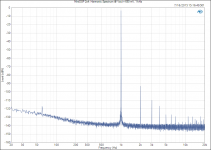 MiniDSP 2x4_ Harmonic Spectrum @ Vout = 650 mV, 1 kHz.png45.3 KB · Views: 545
MiniDSP 2x4_ Harmonic Spectrum @ Vout = 650 mV, 1 kHz.png45.3 KB · Views: 545 -
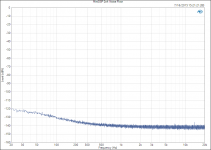 MiniDSP 2x4_ Noise Floor.png35.5 KB · Views: 535
MiniDSP 2x4_ Noise Floor.png35.5 KB · Views: 535 -
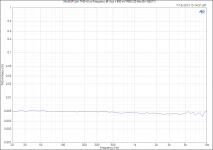 MiniDSP 2x4_ THD+N vs Frequency @ Vout = 650 mV RMS (20 kHz BW AES17).png37.6 KB · Views: 528
MiniDSP 2x4_ THD+N vs Frequency @ Vout = 650 mV RMS (20 kHz BW AES17).png37.6 KB · Views: 528 -
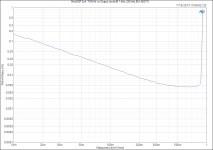 MiniDSP 2x4_ THD+N vs Output Level @ 1 kHz (20 kHz BW AES17).png34.3 KB · Views: 527
MiniDSP 2x4_ THD+N vs Output Level @ 1 kHz (20 kHz BW AES17).png34.3 KB · Views: 527 -
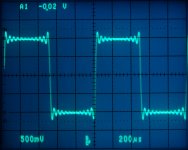 MiniDSP_TransientResponse_1kHz.jpg205.1 KB · Views: 510
MiniDSP_TransientResponse_1kHz.jpg205.1 KB · Views: 510 -
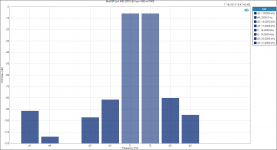 MiniDSP 2x4_ IMD (DFD) @ Vout = 650 mV RMS.png34.6 KB · Views: 202
MiniDSP 2x4_ IMD (DFD) @ Vout = 650 mV RMS.png34.6 KB · Views: 202
Last edited:
Does the board show a pair of lowpass caps on the inlet diff amp? If so, it's more likely their tolerance than layout symmetry.The CMRR is less than stellar. That's to be expected from a discrete solution, though, it looks like the layout could use some tightening up to prevent the degradation above 1 kHz.
The -54dB floor below 100Hz suggests 0.1% matching. If MiniDSP gets that by design rather than good luck coming off the reel IMO that'd be notable.
They appear to be using LC (!) filters on the inputs. The CMRR at higher frequencies could be dominated by the tolerance of the inductors.
I don't know whether they use 0.1 % or 1 % tolerance resistors. -54 dB CMRR would imply 0.2 % matching.
In the old days, resistors were binned which meant you were more likely to get resistors that were closer to the tolerance limits than to the centre of the distribution. I don't know if that's still the case or if the manufacturers have improved the process enough that they can rely on spot testing or skip testing altogether.
Tom
I don't know whether they use 0.1 % or 1 % tolerance resistors. -54 dB CMRR would imply 0.2 % matching.
In the old days, resistors were binned which meant you were more likely to get resistors that were closer to the tolerance limits than to the centre of the distribution. I don't know if that's still the case or if the manufacturers have improved the process enough that they can rely on spot testing or skip testing altogether.
Tom
That'd do it too. What dominates just depends on the LCR values and tolerances chosen; in a well designed circuit caps tend to be the limiting factor but it depends on cost headroom in the BOM and how much the designer optimized.
Since diff amp CMRR is a function of relative pair ratios in a resistor quad there's an extra factor of two. The terminology's not standardized and even in matched quad datasheets it's often unclear exactly what one's getting; I've seen both definitions here in use in the industry. Whether there's a 0.1% take out and its extent would depend on the manufacturers, R values selected, and how the fab lines are operated. In general I would tend to guess probably not so much due to differences in temperature ranges, TCRs, and thermal ratings. It's plausible for certain Susumu selections and straightforward within Yaego's RT series. 0.5% is increasingly popular and doesn't necessarily cost more than 1% so that's a possibility to consider as well.
Since diff amp CMRR is a function of relative pair ratios in a resistor quad there's an extra factor of two. The terminology's not standardized and even in matched quad datasheets it's often unclear exactly what one's getting; I've seen both definitions here in use in the industry. Whether there's a 0.1% take out and its extent would depend on the manufacturers, R values selected, and how the fab lines are operated. In general I would tend to guess probably not so much due to differences in temperature ranges, TCRs, and thermal ratings. It's plausible for certain Susumu selections and straightforward within Yaego's RT series. 0.5% is increasingly popular and doesn't necessarily cost more than 1% so that's a possibility to consider as well.
Noise and distortion. The in blox units also lack a display, which really should have been there when you have volume control.A connector you don't like doesn't make it mediocre. What else is wrong with them?
Last edited:
Noise and distortion. The in blox units also lack a display, which really should have been there when you have volume control.
Well then, many thanks to Tom for posting some proper baseline noise and distortion performance measurements, and providing some thoughts on the trade-offs involved.
The lack of display is a feature-related issue and not a measurement-related issue.
If the noise and distortion performance of the 4x10Hd unit is not acceptable to you, then obviously you will move on and use something different?
Dave.
I'd like to see measurements for something that has significantly better noise and distortion. Clearly Omholt has some to hand and would be nice for him to share.
Personally I like the lack of a display. the behringer line, although very good once all the mods (and the didden volume control) are put in shouts 'stick me in a rack'. Personal opinion of course.
Personally I like the lack of a display. the behringer line, although very good once all the mods (and the didden volume control) are put in shouts 'stick me in a rack'. Personal opinion of course.
Hypex DLCP has better hardware but the software hasn't been completed and is lacking some.
The miniDSP 4x10Hd is good value like mentioned but not a great product. miniDSP as a company seems to be aiming at the budget market and are successful at what they do. However, those who want a stellar product have to look somewhere else. At the moment the choices are few though but there are products and plans on the way.
The miniDSP 4x10Hd is good value like mentioned but not a great product. miniDSP as a company seems to be aiming at the budget market and are successful at what they do. However, those who want a stellar product have to look somewhere else. At the moment the choices are few though but there are products and plans on the way.
Hypex DLCP has better hardware but the software hasn't been completed and is lacking some.
I fully expect Bruno and Hypex to beat MiniDSP on performance. I also expect them to be more expensive than MiniDSP. However, no software -> no product. Sorry, but that's business.
Tom
So still nothing that is superior to the 'mediocre' MiniDSP?
Back on topic I double checked both the 2x8 and 4x10 have all 8 I2S channels on the header. So if an affordable I2S input balanced output DAC card with analog volume control became available that could be a nice upgrade for those that fret about the last few dB.
Back on topic I double checked both the 2x8 and 4x10 have all 8 I2S channels on the header. So if an affordable I2S input balanced output DAC card with analog volume control became available that could be a nice upgrade for those that fret about the last few dB.
For interest I had a look at the specs for the DLCP. http://www.hypex.nl/docs/DLCP_datasheet.pdf . Hard to apples to apples as the hypex output is spec'd at 2.59V but not what sort of volts. But noise is 5.8uV for digital in, which is considerably lower that the miniDSP. And THD+N is not shabby. Although figure 6.2 is causing me some confusion...
It has a software and it works quite well. I use it daily without any issues. But there are room for improvements. miniDSP's software is better and easier to use.
Oh. I thought you said the software hadn't been completed.
The software is actually where I find the MiniDSP lacking the most. I guess it's not horrible, but it's definitely in the "engineering software" category. For an example of a much better user interface, I suggest looking at the ReaEQ plugin for Reaper (REAPER | Audio Production Without Limits).
In the grand scheme of things the software is used rarely. At least if you're into listening to music rather than messing with the XO. I'm willing to deal with some amount of software quirkiness.
I'm surprised the THD+N of the Hypex unit is "only" -102 dB. I'm surprised Hypex didn't choose one of the DACs that get closer to -120 dB. -102 is only 6-7 dB better than the MiniDSP... I also have reservations about the upsampling to 93.75 kHz. I wonder what drove that choice. Usually you get a cleaner impulse response with integer upsampling. Nice low noise though.
At EUR 275 (~$310 at today's exchange rate), the Hypex unit is competitively priced.
Tom
Tom, if the gain is so short that we can't hear what we wanted us to, then I will assume that a preamplifier of your quality specs is a very tall order and needs an expanded timeframe.That's why I designed the Modulus-86 with 20 dB gain rather than the 30+ others use.Tom
I did go to "on break" status once. After returning, I did less frequently, but ever so much better. It is okay, but we'd like to know.
Tom, if the gain is so short that we can't hear what we wanted us to, then I will assume that a preamplifier of your quality specs is a very tall order and needs an expanded timeframe.
I did go to "on break" status once. After returning, I did less frequently, but ever so much better. It is okay, but we'd like to know.
How is gain 'short' nearly all sources at 2VRMS now, so even with a passive pre-amp you just don't need as much gain in the power amp as you used to.
Actually, a lot of lower end sources (phones, tablets, laptops, etc.) run on 3.3 V rails, hence only provide 900 mV RMS. As does the MiniDSP 2x4 single-ended. So Daniel does have a point. However, the best solution from a signal integrity standpoint is to use a preamp with gain rather than cranking up the gain of the power amp. If you need to connect your phone/laptop/tablet directly to the power amp, you'll need a power amp with higher gain. In the MOD86 that can be accomplished by changing one resistor. I would argue that if you are using your phone/laptop/tablet as a source in a high-end system, you really should use an external DAC as the DAC in the phone/laptop/tablet is optimized for low power consumption and not audio performance. A high-end DAC is likely to have a 2.0 V RMS output or 4.0 V RMS differential.
The MiniDSP provides 4.0 V out. Perfect for the MOD86 and other amps with reasonable gain.
Tom
The MiniDSP provides 4.0 V out. Perfect for the MOD86 and other amps with reasonable gain.
Tom
Oh. I also have reservations about the upsampling to 93.75 kHz. I wonder what drove that choice. Usually you get a cleaner impulse response with integer upsampling.
Tom
That is done to stop interference between the input clock and output clock. It reduces jitter and is concepted by Guido Tent.
That is done to stop interference between the input clock and output clock. It reduces jitter and is concepted by Guido Tent.
Why not just keep the input and output on the same clock domain?
Tom
- Status
- This old topic is closed. If you want to reopen this topic, contact a moderator using the "Report Post" button.
- Home
- Source & Line
- Analog Line Level
- MiniDSP 4x10 HD Measurements